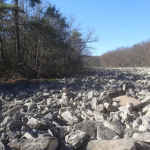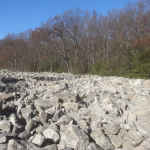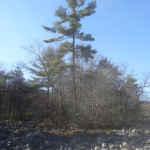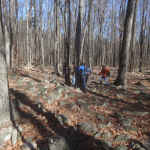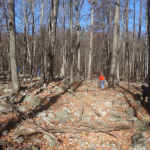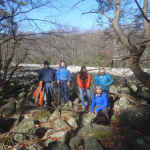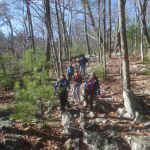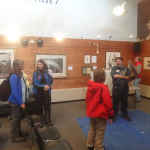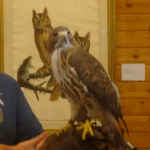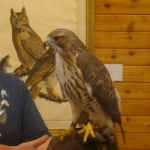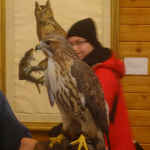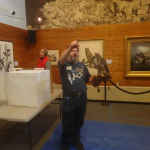- Lookout from the Trail
- View of River of Rocks from the Lookout
- River of Rocks
- River of Rocks
- River of Rocks
- River of Rocks
- River of Rocks
- Here we come.
- Hiking the trail
- The Hikers posing at River Rocks
- Time for lunch.
- Hiking the River of Rocks Trail.
- On our way back up.
- Up the hill we go.
The weather for our November hike was a little cold. When we got there the thermometer registered 29 degrees, but once we got started things began to warm up. Our first stop was at the lookout on Lookout Trail. We spent a little time there looking for the raptors listed as migrating November 15th, which included: the Golden Eagle, Northern Harrier, Red-tailed Hawk, Rough-legged Hawk, Red-shouldered Hawk, Northern Goshawk, and Vulture. The skies were clear with no sign of migrating raptors so we moved on the next lookout with the same results. We were a little disappointed, but were eager to hike versus hanging around. It turns out while we were hiking a number of raptors were counted including two Golden Eagles, but our legs were in the hiking mode versus standing. Soon we came upon the River Of Rocks Trail and opted to start there instead of branching off to another lookout. The River Of Rocks Trail proved a challenge being rather rough and rocky with a steep climb at the end. It was a great loop hike and the river of rocks was rather amazing.
- Program on Raptors
- Red-Tailed Hawk
- Notice the talons.
- Hooked beak.
- Presenter holding Raptor
While we did not see any raptors in the sky, we did get a close up view of a Red-Tailed Hawk in the nature center during one of their programs. We also spent some time prior to hiking discussing and reviewing information on raptors, what they are and what to look for in the sky using flight ID guides and handouts
What did we learn? First of all a raptor is often thought of as a bird of prey. Actually, this is a misnomer since a humming bird and other birds eat prey such as insects. To be a raptor the bird must exhibit 3 major traits: talons, keen vision, and a hooked beak. The talons are very sharp, growing continuously, self-sharpening, and exert many pounds of pressure easily killing prey. A Golden Eagle can exert enough pressure to break a human arm, and a Great Horned Owl can exert 500 lbs. of pressure. A raptor’s vision is 10 times that of a human and binocular with eyes on the front of the skull versus the side. Diurnal raptors, daytime raptors, have many cones in their eyes which are cells that provide acute, colored vision. Nocturnal raptors, those who fly at night, and crepuscular, those flying at dusk and dawn, have more rods, cells which provide for acute, black and white vision in the dark. The hooked beaks are often shaped and designed according to the type of prey the raptor eats. The beaks are very sharp for tearing and are also self-sharpening and grow continuously like the talons. Raptors are grouped into families according to their DNA history. There are five families as seen below. The Hawk Family has 6 sub-categories: Osprey, Kites, Eagles, Northern Harrier, Buteos, and Accipiters, while the Falcon Family has two: Falcon and Caracara. It is interesting to note that the Vulture Family has recently been linked by DNA studies to the Crane Family, but literature has yet to catch up with the change. Buteos are raptors with broad wings and rounded tails often seen soaring in wide circles high in the sky, usually pouncing on their prey on the ground. Accipiters have short, wide rounded wings, long tails and a flap, flap, flap, sail flight pattern. Accipiters are seen mostly in forest and kill other birds on the wing.
FAMILY – Determined by study of DNA
Vulture: Vulture –recently found to be Crane Family
Hawk: Osprey, Kites, *Eagles – Golden Eagle, *Northern Harrier – Northern Harrier, *Buteos – Red Tailed, Rough Legged, Red-Shouldered Hawks, *Accipiters – Northern Goshawk
Falcon: Falcon Caracara
Barn Owl: Barn Owl
True Owls: Owls
* Raptors migrating November 15th
They have a saying about raptors and the rules they follow: Hunt Hard, Kill Swiftly, Waste Nothing, Offer No Apologies.
Thanks Sean for the wonderful pictures!





